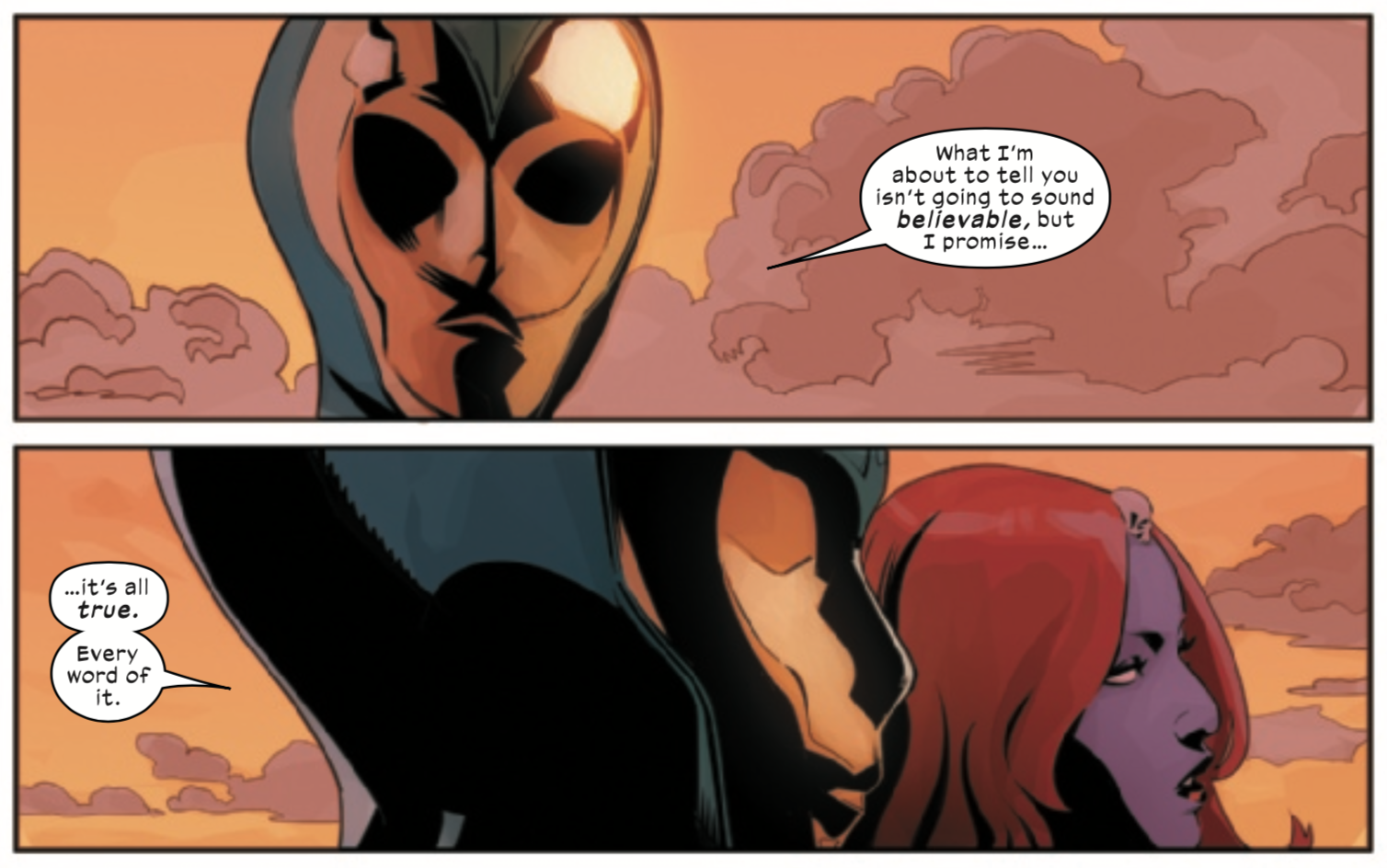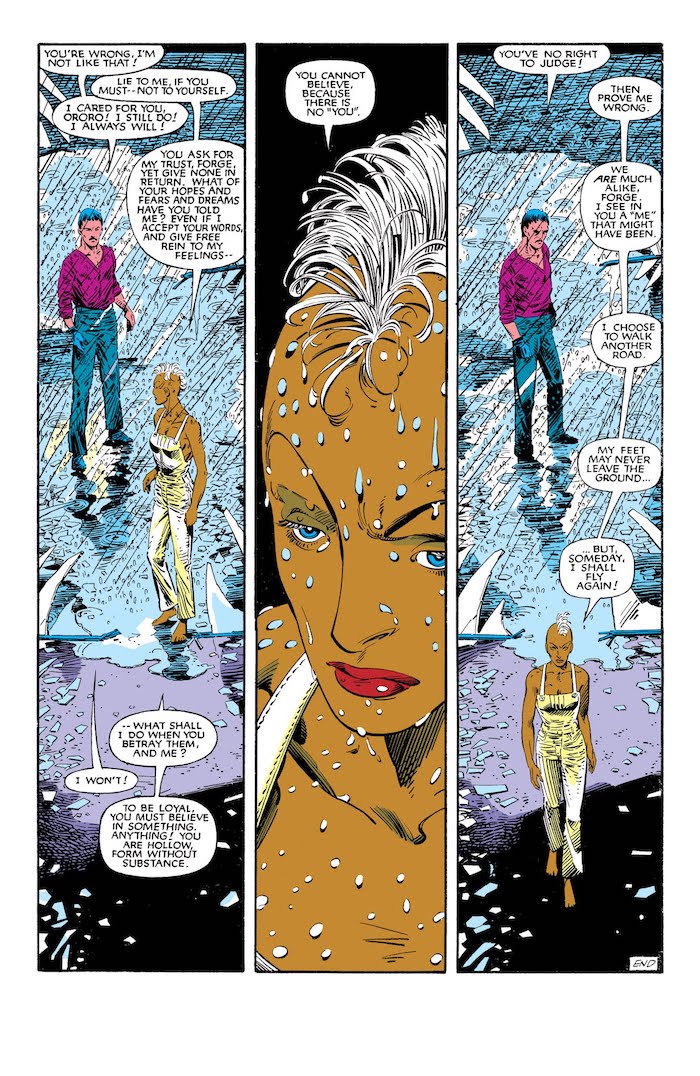The Oracle
“The Oracle”
X-Men #6
Written by Jonathan Hickman
Art by Matteo Buffagni
Color art by Sunny Gho
My favorite narrative threads introduced by Jonathan Hickman in House of X – the machinations of Orchis, the confrontation of Moira and Destiny, the suicide mission on the Orchis forge, the looming threat of Nimrod, Xavier and Magneto using the promise of resurrecting Destiny as a method of manipulating Mystique – come together in “The Oracle,” the best single issue of an X-comic to come out since House of X/Powers of X gave way to the Dawn of X. Given that we’ve had to wait a bit for this to come together makes it feel like a payoff, but it’s still just set up. We now have a full sense of Mystique’s arc for the Hickman X-Men mega-story, and it’s something that pulls together everything that’s ever been interesting about one of the franchise’s greatest antagonists: Her nihilistic cynicism, her duplicitous and conspiratorial nature, her deep love for Destiny, and her limitless capacity for spite and bitterness. At the end of this issue Mystique is set on a course to become a threat to the grand project of Krakoa for reasons that make a lot of emotional sense. Even if she ends up doing horrible things, it’s easy to be on her side in this.
At the beginning and end of the issue we see Destiny and Mystique together in flashback, as Mystique is told a vague prophecy that lines up with her experiences in the present. I love seeing them together because it’s the only time you ever see Mystique be vulnerable or deferential with another person. Destiny is the only person she truly trusts and admires, and there’s an implication that she’s also somewhat responsible for her political radicalization. Hickman’s characterization of Destiny is not far off from Chris Claremont’s depiction of her in the 1980s, but he leans harder on her essential spookiness and her icy ruthlessness. “They want us blind for some reason,” she says, accurately sensing that the removal of her special form of sight is deliberate. Moira’s fear of Destiny is rooted in her traumatic experience with her at the end of her third life and is tied to her tremendous guilt for her actions in that timeline, but I also get the impression that she understands that if anyone would call bullshit on the Krakoan mutant togetherness project and have the means to build a faction of skeptical mutants it’s Destiny and Mystique. Moira’s anxiety about this has now guaranteed that it will come to pass.
The panel in which Mystique shouts “I WANT MY WIFE BACK!” at Xavier and Magneto is the emotional climax of the issue, but has more power in that Hickman is finally spelling out something that’s been elided for decades due to editorial policies, though it was screamingly obvious to anyone who read Claremont’s comics. This isn’t actually the first time the nature of their relationship has been made canon, but it’s certainly the most important. The metatextual aspect of this adds to a few extra layers of pathos to the story, particularly when you consider that Claremont’s writing implied they’d been living together as a lesbian couple for several decades and that they were as out with that as they were about being mutants, though Mystique’s shape-shifting always gave her the option to pass.
One of the ways Xavier and Magneto are using their leverage over Mystique to their advantage is by having her spy on the Orchis station to make sure that the X-Men’s mission in House of X was actually successful, as they all died out of range of Cerebro and no one had retained their memories when they were resurrected. She returns with a good news/bad news message: Yes, the Mother Mold was destroyed, but it seems as though Dr. Gregor and Director Devo are moving along in creating something that looks quite a lot like Nimrod. We don’t actually know what the Orchis scientists are doing, though it’s connected with Gregor’s odd plan to revive her husband who died in the X-Men’s raid, but it moves that plot along in a way that invites speculation. It moves Mystique’s story forward by complicating her motivations – she cares enough about her people to want to stop Orchis, but not enough that she is willing to do anything more until she gets Destiny back. She tries to use this as leverage over Xavier and Magneto, and fails. The bitterness sets in, and it’s clear those men have no idea how much of a mistake they’re making by protecting Moira.
Some notes:
• Hickman has been writing Xavier and Magneto as a gay couple in subtextual ways, so it’s interesting that they’re the ones thwarting the reunion of a lesbian couple whose relationship is now entirely official in the text.
• The plot point of Dr. Alia Gregor seemingly attempting to revive her dead husband in the form of Nimrod is a clever thematic parallel with Mystique’s quest to revive her lost wife, but also a cruel irony in that by raiding the Orchis forge, the X-Men apparently hastened the creation of the thing they were desperately trying to prevent. And I like that there’s a more poignant emotional context for the origin of Nimrod – it’s not just motivated by MUTANTS BAD, but rather a consequence of mutant aggression.
• Matteo Buffagni did a wonderful job as a fill-in artist on this issue, and his Sean Phillips/David Mazzucchelli-ish inky noir qualities were very well-suited to this particular story. I’m particularly fond of how he drew the subtleties of body language in the Destiny/Mystique flashbacks and how the surreal aspects of Krakoa appeared when filtered through his blunt realism.
• The page revealing Mystique’s appearance in disguise in earlier scenes in the Orchis station was brilliantly executed, and recalls a similar trick Hickman used in his Avengers run showing the reader how the boy who became Starbrand had been in the backgrounds of scenes through the issue.
• This is the first issue of an X-Men comic since House of X #1 to not include text pages, and the issue contains a few extra pages of art instead. They made the right choice here for the story, but I think that breaking the formal pattern was a subtle nod that this issue was meant to seem particularly heavy.
• Gotta love the very low-key introduction of SENTINEL CITY on Mercury. Yikes!





















